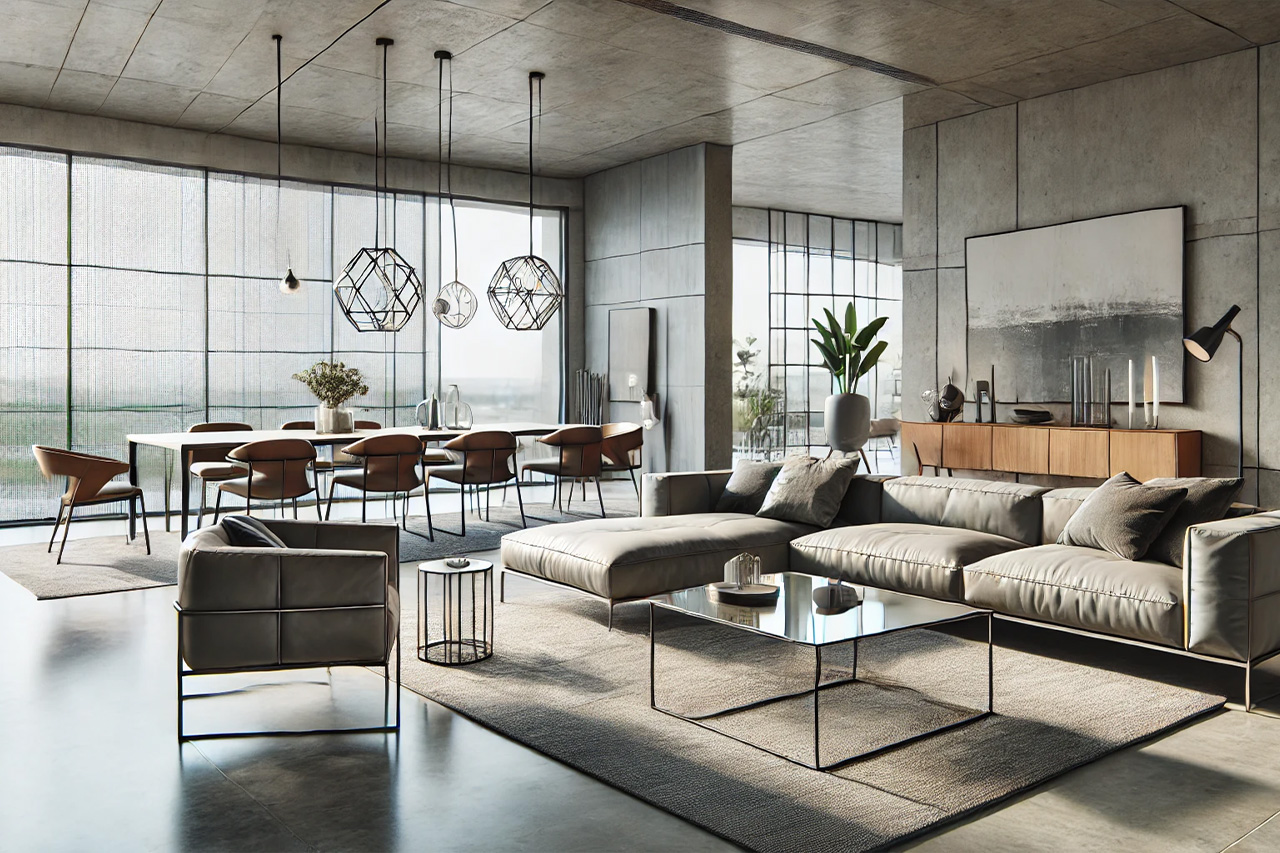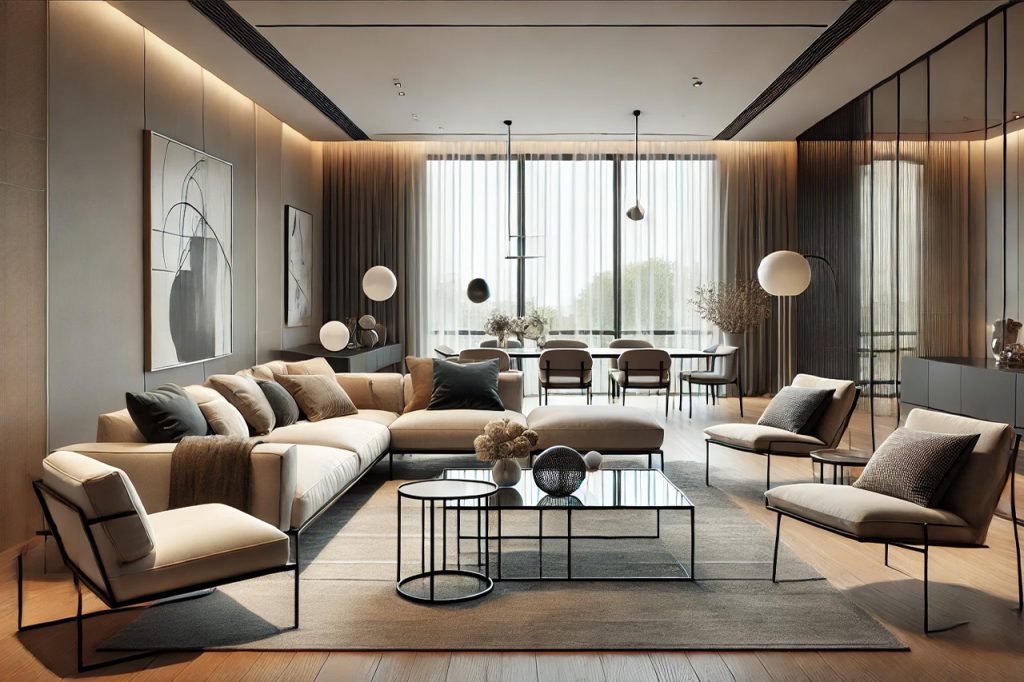Introduction
Definition of Modern Furniture Style
Modern furniture style is characterized by simple and clean lines, the absence of unnecessary details, and an emphasis on functionality. The main features of this style include minimalism, the use of natural materials, a neutral color palette, and innovative solutions.
Minimalism in modern style is evident in the lack of ornamentation and decorations. Furniture has simple geometric shapes, creating a sense of space and order. The use of natural materials such as wood, metal, and glass adds a touch of nature and eco-friendliness to the interior. Neutral colors like white, gray, black, and beige create a calm and harmonious atmosphere.
History and Development of Modern Furniture Design
The history of modern furniture style began in the mid-20th century when designers started experimenting with new materials and technologies. One of the first movements that influenced the development of modern style was the Bauhaus, a German design school that promoted functionality, simplicity, and rationality in furniture design.
In the 1950s, the first examples of modern furniture appeared, which remain relevant to this day. This was a period when designers like Charles and Ray Eames created iconic furniture pieces that combined aesthetics with functionality. They used new materials like plywood and fiberglass to create furniture that was not only beautiful but also comfortable and durable.
In the following decades, modern furniture style continued to evolve. In the 1960s and 1970s, new technologies emerged that allowed the creation of furniture from plastic and other innovative materials. This enabled designers to experiment with shapes and colors, creating unique and functional pieces.
At the beginning of the 21st century, modern furniture style gained even more popularity. The growing focus on ecology influenced the choice of materials used in furniture design. The revival of interest in natural materials such as wood and stone contributed to the creation of eco-friendly and durable products.
Today, modern furniture style continues to evolve, incorporating the latest technologies and innovative solutions. Smart furniture with built-in gadgets, adjustable elements, and multifunctional designs have become an integral part of modern interiors. Additionally, designers are increasingly focusing on the individual needs of users, creating furniture that best suits their requirements and lifestyle.
Key Characteristics of Modern Furniture Style
Minimalism and Clean Lines
Modern furniture style is defined by its minimalist aesthetic. The key principle is “less is more.” In this style, there is no room for excessive decorations, intricate ornaments, or elaborate detailing. Instead, the focus is on simple geometric shapes and clean lines that create a sense of space and order. Modern furniture often features sharp contours and symmetrical proportions, adding elegance and restraint.
Minimalism promotes an interior that looks neat and organized. The absence of unnecessary details allows the focus to remain on the essential elements of design and functionality. This creates a tranquil and harmonious atmosphere, which is particularly important in the fast-paced modern world.
Use of Natural Materials
Modern furniture style actively incorporates natural materials such as wood, metal, glass, and textiles. This not only adds aesthetic appeal but also underscores the eco-friendliness and durability of the pieces. Wood, for instance, is often used in furniture making due to its natural beauty, warmth, and versatility. It can be finished in various ways, allowing for the creation of unique textures and shades.
Metal and glass give the interior a contemporary look, adding a sense of lightness and transparency to the furniture. These materials are often combined with others to create contrast and depth in design. Textile elements, such as natural fabrics and leather, add comfort and coziness, making furniture not only beautiful but also practical in use.
Functional Design
Functionality is one of the key characteristics of modern furniture style. Every element of the design must serve a practical purpose. This means that furniture should not only be aesthetically pleasing but also comfortable and practical to use. For example, open shelves, fold-out sofas, multifunctional tables, and modular storage systems allow for the most efficient use of space and meet various user needs.
Functional design contributes to the creation of interiors that align with modern lifestyles. The adaptability and multifunctionality of furniture that meets specific user requirements make life more convenient and comfortable.
Innovative Solutions
Modern furniture style is constantly evolving, incorporating innovative solutions that make life even more convenient. The use of the latest technologies and materials allows for the creation of furniture with unique properties and functions. For example, smart furniture with built-in gadgets, adjustable elements such as height-adjustable tables, or furniture with integrated lighting systems has become popular among consumers.
Innovative solutions also include the use of eco-friendly and recycled materials, contributing to a reduced environmental impact. This aligns with modern trends in sustainable development and resource conservation.
Features of Modern Furniture Design
Minimalist Approach
Minimalism is a fundamental principle of modern furniture design. This approach emphasizes simplicity, functionality, and aesthetics. Minimalist furniture is distinguished by the absence of unnecessary details and decorations, creating a sense of space and lightness. The simplicity of forms and lines allows the focus to remain on the essential elements of the design, highlighting their beauty and functionality.
Minimalism also helps reduce clutter in the interior, which is important for creating a comfortable and harmonious space. Furniture with a minimalist design easily fits into any interior, adding elegance and restraint. The use of minimalist principles helps create furniture that is not only stylish but also practical in use.
Use of Neutral Colors
Neutral colors play a significant role in modern furniture design. They create a calm and harmonious atmosphere, promoting relaxation and comfort. The most commonly used colors include white, gray, black, and beige. These colors are universal and easily combine with other shades and decorative elements.
The use of neutral colors allows for the creation of a clean and elegant appearance for furniture. They serve as an ideal backdrop for accent details and decorative elements such as cushions, paintings, or houseplants. Neutral colors also help visually expand the space, making the room brighter and more spacious.
Geometric Shapes
Geometric shapes are another characteristic feature of modern furniture design. The simplicity of shapes, such as squares, rectangles, circles, and triangles, creates structure and order in the interior. Geometric shapes give furniture clarity and symmetry, emphasizing its modern appearance.
Geometry in furniture design can be expressed both in the form of the furniture itself and in its details and elements. For example, tables may have clear rectangular or round shapes, while chairs may feature geometrically precise backs and seats. The use of geometric shapes helps create visual order and harmony in the interior.
High-Tech Elements
High-tech is another important component of modern furniture design. This style emphasizes the use of the latest technologies and materials, adding innovation and functionality to the furniture. High-tech elements often include chrome surfaces, glass inserts, and metal structures.
Furniture in the high-tech style may feature integrated technologies such as lighting systems, charging devices, or built-in speakers. This makes them not only stylish but also highly practical. High-tech elements give the interior a modern look and highlight the technological sophistication of the furniture.
Eco-Friendly and Innovative Trends in Modern Furniture Design
Eco-Friendly Modern Furniture
Eco-friendly trends are playing an increasingly important role in modern furniture design. Consumers are becoming more conscious of the impact of their purchases on the environment, prompting designers and manufacturers to create furniture that is environmentally friendly and sustainable. Eco-friendly furniture is made from materials that have a minimal environmental impact and can be recycled or reused.
The production of eco-friendly furniture involves the use of technologies that reduce harmful emissions and conserve resources. For example, furniture made from recycled wood or metal helps reduce waste and preserve natural resources. Additionally, the use of natural paints and varnishes free from harmful chemicals makes furniture safe for both human health and the environment.
Furniture Made from Natural Materials
Natural materials have always been popular in furniture design, but in the modern era, they are taking on new significance. The use of wood, stone, leather, and textiles made from natural fibers has become an important part of the eco-friendly and healthy approach to furniture creation. Wood, for example, is a renewable resource, and when forests are managed responsibly, it can be used without harming the ecosystem.
Wood not only adds warmth and natural beauty to the interior but also contributes to creating a healthy indoor climate. It can regulate humidity and purify the air, positively affecting people’s well-being. Stone and other natural materials add strength and durability to the interior, while textiles made from natural fibers such as cotton, linen, or wool provide comfort and aesthetic pleasure.
Innovative Materials and Technologies
Innovation plays a crucial role in modern furniture design, allowing for the creation of products with new properties and functions. One example is the use of composite materials that combine the advantages of different components and can be lighter, stronger, or more flexible than traditional materials. Materials made from recycled waste have also become popular, reducing environmental impact and adding uniqueness to the final products.
3D printing technologies open new possibilities for furniture design, allowing for the creation of complex shapes and structures that would be impossible with traditional methods. This enables the production of custom-made furniture tailored to individual needs and preferences, making it more comfortable and functional.
Smart furniture is another innovative trend that is actively developing. Built-in electronic systems such as adjustable lighting, charging devices, audio systems, and other gadgets make furniture more interactive and convenient to use. These solutions allow for the integration of furniture with other elements of a smart interior, creating a cohesive and functional system.
Tips for Choosing Modern Furniture
How to Choose Furniture for Your Interior
Choosing modern furniture for your interior is an important task that requires considering several key aspects. First of all, pay attention to the overall style of your home. Modern furniture typically features minimalism, clean lines, and functionality, making it well-suited for simple, spacious interiors.
- Dimensions and Proportions: Be sure to measure the room before purchasing furniture to ensure it will fit in size. Choose furniture that complements the space without overwhelming it.
- Functionality: Modern furniture often serves multiple functions. For example, fold-out sofas, tables with extra storage compartments, or transformable shelving units. Such furniture not only saves space but also adds practicality.
- Materials and Quality: Opt for furniture made from natural materials such as wood, metal, or glass. They not only look stylish but also last longer.
Conclusion
The future of furniture design looks exciting and innovative. One of the main trends will be the further development of eco-friendly solutions. The use of recycled materials, environmentally friendly paints and varnishes, and technologies that reduce environmental impact will become even more popular.
Another important trend will be the increased functionality and adaptability of furniture. Smart furniture with built-in gadgets and interactive functions is becoming increasingly popular. It allows for the creation of spaces that meet individual needs and lifestyles.
Modern furniture style offers many advantages, making it an ideal choice for creating a comfortable, stylish, and functional interior. Future trends in furniture design promise even more innovations and eco-friendly solutions, making our homes even more enjoyable to live in.




